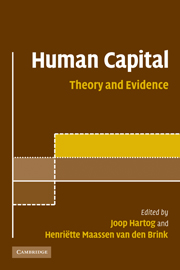Book contents
- Frontmatter
- Contents
- List of figures
- List of tables
- Notes on contributors
- Prologue
- Part I Measuring the benefits from human capital
- 1 What should you know about the private returns to education?
- 2 The social returns to education
- 3 Returns to training
- 4 Human capital and entrepreneurs
- 5 The effects of education on health
- 6 Are successful parents the secret to success?
- Part II Applying and extending the human capital model
- Part III Policy interventions
- Epilogue: some reflections on educational policies
- A note on econometrics
- Index
- References
6 - Are successful parents the secret to success?
Published online by Cambridge University Press: 22 September 2009
- Frontmatter
- Contents
- List of figures
- List of tables
- Notes on contributors
- Prologue
- Part I Measuring the benefits from human capital
- 1 What should you know about the private returns to education?
- 2 The social returns to education
- 3 Returns to training
- 4 Human capital and entrepreneurs
- 5 The effects of education on health
- 6 Are successful parents the secret to success?
- Part II Applying and extending the human capital model
- Part III Policy interventions
- Epilogue: some reflections on educational policies
- A note on econometrics
- Index
- References
Summary
Introduction
Almost all studies, varying over countries and times, show that when parents are rich and better educated their children tend to receive more schooling and income as well. In the United States, for example, intergenerational correlations of schooling and earnings are close to 0.4 (Solon 1992). And even in Sweden, where education is heavily subsidized, the intergenerational correlations are substantial and move between 0.2 and 0.3 (Björklund and Jäntti, 1997). Recently Haveman and Wolfe (1995) reviewed the mobility literature and came to the conclusion that the human capital of parents, typically measured by the number of years of schooling attained, is the most fundamental factor in explaining the child's success in school. Apparently the evidence on family background is quite persuasive: if you want to be successful, just have successful parents.
But if parents are indeed the secret to success, does this mean that if we – or policy-makers for that matter – make people more successful, their future children will do better as well? This question will serve as the outline of this chapter. Answers will not come easily as our understanding of why successful parents have successful children is at most tentative (Solon, 1999). There could be many family factors at work. Are, for example, parental abilities responsible for economic success passed on genetically to the next generation? Or are better-educated and richer parents better in providing an intellectually stimulating environment for their children? Or do poorer parents face credit constraints when financing their children's education?
- Type
- Chapter
- Information
- Human CapitalAdvances in Theory and Evidence, pp. 81 - 98Publisher: Cambridge University PressPrint publication year: 2007
References
- 1
- Cited by



